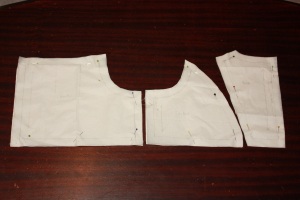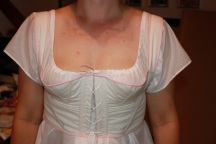Last year when I attended the Jane Austen Festival, I remember my sister saying how comfortable her short stays were. She felt well supported but not restricted from doing the things she wanted to do. One of the problems I have always had with historic costuming is how restrictive the fashions could be for women, which has the undesirable effect of making you feel uncomfortable when you are wanting to have fun! So for this reason, I decided to have a go at some Regency short stays for myself.
I had planned to do these as part of the Historical-Sew Fortnightly Challenge #3: “Under it all” (for undergarments), due February 11, but I have finished them a tad early!
The corsets, or stays, of this era were first “transitional” (where they transitioned from the eighteenth century stays to the new Regency style) and then they are commonly thought to have been either long or short, with usually little or no boning. The Regency style of stays really just provided posture support and helped to define a high empire waistline, with a “bust-shelf”, that was popular in the fashions of the day. In researching short stays, I have struggled to find information on historically accurate short stays from primary sources of the period (such as pictures, paintings or extant examples). If you are interested in historical research of the so-called “short stays”, have a look at ‘Short Stays’ Studies by Kleindung um 1800, which examines some historical patterns and journals on the topic.
Pattern and Construction Details
Step One: First I drafted my own pattern using the method I used for my long stays (My Regency Journey: How to draft a corset pattern). I found this process a lot more difficult to do than I had previously, mainly because I did not have much of an idea what these types of stays looked like. I could not find many extant examples online, except for modern historical patterns (such as Sense and Sensibility Patterns) that mention that they are based on extant examples and pictures of the era. I decided to do a toile out of calico, just to make sure that it fitted properly, and then I adjusted the pattern pieces accordingly.

Toile pattern pieces: Front, side back and back. I ended up taking off quite a bit at the side seams, and adjusting the curve of the side back. Gusset pieces are not pictured.
Step Two: I cut out the fabric, making sure I added the seam allowances. For these stays, I have used three layers of material: the outer and inner layer are white cotton broadcloth, and the interlining is cotton calico.
Step Three: Beginning with the front pieces, I sewed along the centre front seams so that the three layers were all attached and could then be turned with the right sides facing out.
Step Four: Again treating the outer layer and interlining as one piece, the side back and back pieces were sewn, leaving the front lining pieces free.
Step Five: For the gussets, I cut slits through all three layers in the top of the front pieces. The slits were marked on my pattern piece and are placed either side of the nipple area. For this reason it can be useful to have a bust separation measurement (the distance between the nipples) for that part of the pattern drafting. I used the instructions from Sempstress’s tutorial on setting gussets, which made it very straightforward.
Step Six: As you can see in the picture above, I began decorating the outer layers at this point.
- Boning Channels: I decided to run a decorative stitch along the outer layer of the boning channels, just to make them pretty! I had a line of nylon boning on each side of the eyelets at the centre front, one line of boning on each side seam, and one line of boning running diagonally from under the arm, forward, to the bottom of the corset.
- Cording: I did three lines of cording, with cotton cord, running horizontally under the bust on each side.
- Decorative stitching: I added a bit of decorative machine embroidery stitching around the bust gussets. I also did some extra lines of this stitching along some of the back seams (see below).
- Embroidery: Just because I love embroidery, I decided to draw out the outline of a little flower stem that I had in my stamp collection. Using a basic backstitch with some coloured embroidery thread, I followed the lines. So pretty!
Step Seven: In order to complete the lining, I sewed the side back and the back pieces of the lining together. Then I laid it on top of the outer layers (wrong sides together) and sewed a decorative stitch as a topstitch along the back seam lines, through all the layers. For the side seams, the side back lining edge was folded under and pinned to the front lining edge, with the same decorative stitch being sewn through all layers. This seemed an easy way to get the lining attached without fiddling around too much with it!
Step Eight: The straps were attached. The eyelets were hand sewn and laced with a length of cotton cording. The garment was then bound with bias binding around the top and bottom edges and around the armholes.
It took a few hours for me to draft the pattern, almost two days to get the toile adjusted and looking right, and then three full days of my holidays to sew it. The total cost was approximately $12 AUD. As the fabric, sewing thread, embroidery thread, and boning, were already in my stash box, the only thing I actually bought was the cotton cording and the binding (which came to $5).
I am really pleased with the fit. It really does pay to do an accurate toile first for less fitting dramas later. And I am really pleased with how pretty it is!
For more Regency costumes, go to My Regency Journey.
Related Posts
My Regency Journey: How to draft a corset pattern
My Regency Journey: Corset Construction – construction of a pair of long stays.
Sources and Relevant Links
A pair of transitional stays (pictured), from the Victoria and Albert Museum.
Another example of a cotton Regency corset (c. 1800-1825) – from the National Trust website
How to set a triangular gusset – Sempstress
Achieving a proper fit with Regency stays – by Oregon Regency Society
Examples and pictures of Regency era underwear – Jessamyn’s Regency Costume Companion
Jane Austen Festival, Australia – website
Historical Sew-Fortnightly – hosted by Dreamstress
‘Short Stays’ Studies, by Kleidung um 1800 – a great blog post looking at a book published in 1810 by J.S. Bernhardt, on the construction of a ‘new’ sort of stays.
























